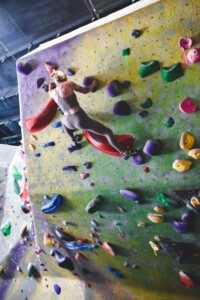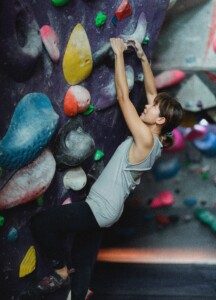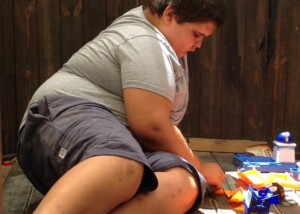Bouldering is a form of climbing that can be done indoors at gyms dedicated to bouldering; no rope or harness required.
Autistic kids will benefit tremendously from bouldering.
Bouldering is a GREAT sport for autistic children and teens – for multiple reasons.
As an Autistic myself who climbs at a bouldering gym, I urge all parents of autistic kids – especially with a diagnosis of Level 1 – to give this form of climbing a try.
What is bouldering?
It’s a form of climbing in which you’re close enough to the floor so that a rope and harness system is not required.
A partner is not needed, either, though often, people boulder in pairs or groups.
Many people boulder in solitude as well.
A bouldering gym will have “crash pads,” or a flooring below the routes that’s thick and durable, and easily supports a landing on one’s feet from high up.
I’ve seen kids jump off a route from 12 or more feet up, landing on their feet without any problem.
Bouldering gyms typically offer beginner classes, but these are not required to just go into the gym and start climbing.
These gyms have routes for novice children.
If your autistic child is hesitant to climb to the top, that’s perfectly fine. Many people climb only partway.

Unsplash/Ashlyn Ciara
Teaches Looking Ahead at a Situation
Climbing is like playing chess on a wall. Your autistic child will learn to plan ahead, because the climber must calculate which hold to reach for next – and how to reach for it, and how to maneuver their body as they hold onto that next hold.
Bouldering will teach your autistic son or daughter how to think ahead.
This skill will have major applications in life situations as well as living as independently as possible.
Life is always about deciding what choices to make that will impact someone in the near future.
Climbing in childhood will sharpen this skill. There are kids who’ve been climbing long enough to be able to look at a climbing route for the very first time, and know in advance how they will climb it.
Teaches How to Take Turns and How to Be Patient
If there’s enough people in the gym, they need to take turns. This includes children waiting their turn to get on a route that several other people are interested in.
Autistic kids will also improve their ability to read nonverbal communication that means, “I’m done,” and, “I was waiting to try that route ahead of you.”
Furthermore, sometimes climbers need to wait because someone is on a nearby route that overlaps the one they want to get on.
Teaches Consideration of Alternatives and Different Options to a Problem
There is no climbing route in existence that can be ascended only one way.
Even people with the same body proportions, height and weight will climb a single route differently. The permutations of hand, torso, hip, leg and foot positions are endless.
Thus, bouldering will teach your autistic child to consider alternatives to solving a problem.
They will learn there’s more than one way to approach a sticky situation. Bouldering will help give some flexibility to rigid thinking!
Coordination and Running in a Straight Line Are Not Required
If your autistic child has dyspraxia or is exceptionally clumsy, this won’t matter.
Climbing is a very slow activity. It doesn’t require quick reflexes or agility.
So if your autistic child lets balls smack them in the face because they can’t catch well, this WON’T MATTER when it’s time to climb a route.
Boosts Self-Confidence
Life is about getting to the top. Adults forever are trying to “stay on top” of situations.
Professionals want to “climb the latter of success” or “work their way up to the top.”
Reaching the top of a climbing route symbolizes what human beings need to do to be successful in life.
I don’t mean only successful with holding down gainful employment, but successful in all aspects of adulting such as keeping up with paying the bills.
Getting to the top of a challenging route is thrilling even for neurotypical adults.
I see this all the time when someone finally, after many attempts, is able to get their hand on that last hold, then to seal the deal, pat it with their other hand.
Imagine what it will do to a child’s work ethic when they try a new route and struggle, able to get only halfway up…
…But then half an hour later they have the entire thing “linked,” in that they can effortlessly ascend it to the very top. They figured out a problem. They solved a problem all by themselves.
Bonus Benefit!
Climbing will significantly improve the autistic child’s ability to know where their body is in space.
This ability is called proprioception. Bouldering will enormously increase proprioception, which many autistic children struggle with.
Autism May Be an Advantage in Climbing
Because autistic people, including children, tend to think outside the box, this way of viewing a tricky situation can come in handy when on a tough route.
Additionally, the hyperfocus that comes with Autism Spectrum Disorder will be put to grand use by the autistic climber.
If your child is autistic — no matter how “off” their gait is — bring them to a bouldering gym and see what happens.
Call ahead of time, though, to find out when the quietest periods are, though not all autistic kids would mind a fuller gym.
Even if your autistic child openly stims or is nonspeaking, you should NOT let these factors stop you from taking them to a bouldering gym.
What about safety?
Relative to more traditional athletic activities, bouldering is an extremely safe sport.
It’s very intriguing that some parents won’t think twice about their autistic child riding a bicycle around the neighborhood, yet fear they’ll “get hurt” climbing.
According to a study, over 600 children in the U.S. every day go to the ER for bicycle related injuries.
According to the Consumer Product Safety Commission, here are the sports most likely to injure a child.
Football, basketball, bicycling, baseball, softball, soccer, skateboarding, trampolines, roller skating, skiing, snowboarding, ice hockey.
Also ranking high is gymnastics and cheerleading.
Your autistic young child is far more likely to get injured on playground equipment than inside a bouldering gym.
According to the CPSC, over 200,000 U.S. children 14 and under go to the ER for playground related injuries every year.
The extremely higher incidence of injuries from common activities, when compared to bouldering, CANNOT BE EXPLAINED AWAY by the higher number of kids who engage in common activities!
The higher rate of injuries is due to the nature of the activity!
When my neurotypical niece was seven, she was hanging on playground equipment while her mother was reading nearby.
Suddenly her mother heard a cry, looked up and saw her daughter on the hard ground, holding her arm — which at the ER was diagnosed as broken, requiring a cast.
When children “pop off” a bouldering route, they land on a superbly shock-absorbing, cushiony surface.
A bouldering class will also teach children how to anticipate popping off and how to position their body when this happens to optimize the soft landing.
Bouldering is a fantastic and safe sport for kids on the Autism Spectrum.
 Lorra Garrick has been covering medical and fitness topics for many years, having written thousands of articles for print magazines and websites, including as a ghostwriter. She’s also a former ACE-certified personal trainer. In 2022 she received a diagnosis of Level 1 Autism Spectrum Disorder.
Lorra Garrick has been covering medical and fitness topics for many years, having written thousands of articles for print magazines and websites, including as a ghostwriter. She’s also a former ACE-certified personal trainer. In 2022 she received a diagnosis of Level 1 Autism Spectrum Disorder.
.










































